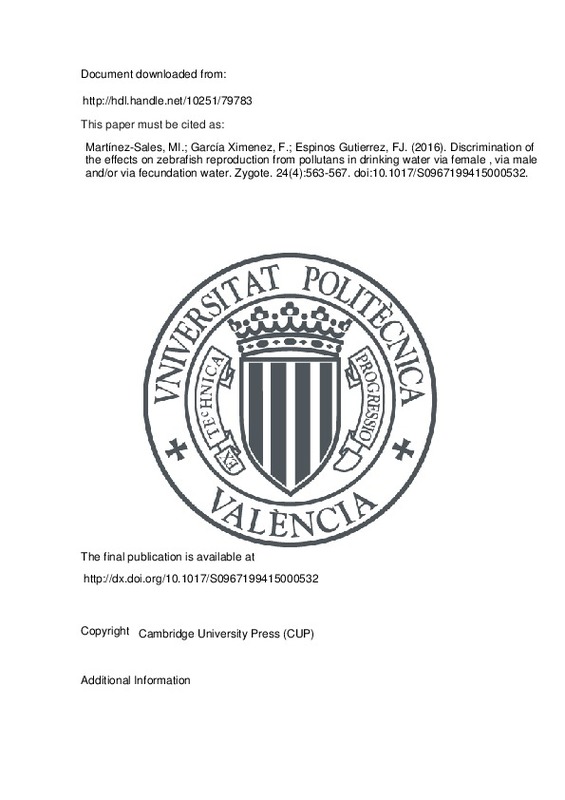JavaScript is disabled for your browser. Some features of this site may not work without it.
Buscar en RiuNet
Listar
Mi cuenta
Estadísticas
Ayuda RiuNet
Admin. UPV
Discrimination of the effects on zebrafish reproduction from pollutans in drinking water via female , via male and/or via fecundation water
Mostrar el registro sencillo del ítem
Ficheros en el ítem
| dc.contributor.author | Martínez-Sales, María Isabel
|
es_ES |
| dc.contributor.author | García Ximenez, Fernando
|
es_ES |
| dc.contributor.author | Espinos Gutierrez, Francisco Juan
|
es_ES |
| dc.date.accessioned | 2017-04-19T07:21:51Z | |
| dc.date.available | 2017-04-19T07:21:51Z | |
| dc.date.issued | 2016-08 | |
| dc.identifier.issn | 0967-1994 | |
| dc.identifier.uri | http://hdl.handle.net/10251/79783 | |
| dc.description.abstract | [EN] The lack of preventive policy legislation and the low removal rate of organic pollutants in conventional potabilization treatments lead to some of them being present in drinking water. The problem arises because some of these substances have detrimental effects on human reproduction health, via females, via males or even both. In this work, we established the zebrafish as a bioindicator of these types of substances with the goal of discriminating the effects through three different pathways: male, female or water where the fertilization took place. For this purpose, four parameters were analysed: fertility rate, hatching rate and survival and abnormalities rates. So, for each parameter two groups were formed, according to whether adult males or females were reared in bottled spring water (Z) or tap water (B) and if the in vitro fertilization took place in water Z or B. Results revealed a decline in the fertility and hatching rate in water B, due to a water effect. The most plausible explanation could be the presence of substances which affect the micropyle and chorion. Moreover, a decrease in the fertility rate due to an effect over the female was also observed, but in this case by an alteration of the oocyte quality. | es_ES |
| dc.language | Inglés | es_ES |
| dc.publisher | Cambridge University Press (CUP) | es_ES |
| dc.relation.ispartof | Zygote | es_ES |
| dc.rights | Reserva de todos los derechos | es_ES |
| dc.subject | Reproductive effects | es_ES |
| dc.subject | Drinking water | es_ES |
| dc.subject | Zebrafish | es_ES |
| dc.subject | Bioindicator | es_ES |
| dc.subject | Organic pollutans | es_ES |
| dc.subject.classification | BIOLOGIA ANIMAL | es_ES |
| dc.subject.classification | PRODUCCION ANIMAL | es_ES |
| dc.title | Discrimination of the effects on zebrafish reproduction from pollutans in drinking water via female , via male and/or via fecundation water | es_ES |
| dc.type | Artículo | es_ES |
| dc.identifier.doi | 10.1017/S0967199415000532 | |
| dc.rights.accessRights | Abierto | es_ES |
| dc.contributor.affiliation | Universitat Politècnica de València. Escuela Técnica Superior de Ingeniería Agronómica y del Medio Natural - Escola Tècnica Superior d'Enginyeria Agronòmica i del Medi Natural | es_ES |
| dc.contributor.affiliation | Universitat Politècnica de València. Departamento de Ciencia Animal - Departament de Ciència Animal | es_ES |
| dc.description.bibliographicCitation | Martínez-Sales, MI.; García Ximenez, F.; Espinos Gutierrez, FJ. (2016). Discrimination of the effects on zebrafish reproduction from pollutans in drinking water via female , via male and/or via fecundation water. Zygote. 24(4):563-567. doi:10.1017/S0967199415000532 | es_ES |
| dc.description.accrualMethod | S | es_ES |
| dc.relation.publisherversion | http://dx.doi.org/10.1017/S0967199415000532 | es_ES |
| dc.description.upvformatpinicio | 563 | es_ES |
| dc.description.upvformatpfin | 567 | es_ES |
| dc.type.version | info:eu-repo/semantics/publishedVersion | es_ES |
| dc.description.volume | 24 | es_ES |
| dc.description.issue | 4 | es_ES |
| dc.relation.senia | 303282 | es_ES |
| dc.identifier.eissn | 1469-8730 | |
| dc.identifier.pmid | 26450064 |







![[Cerrado]](/themes/UPV/images/candado.png)

